How to choose the best pancake pan?
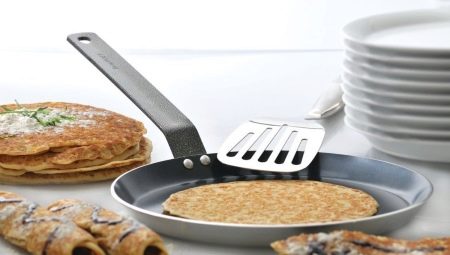
Our grandmothers knew how to cook delicious pancakes, and the choice of pans was not before them, since the industry did not indulge in an abundance of goods. It is more difficult for our contemporaries. Stores are overflowing with products from different materials with all kinds of coatings, which have different thicknesses and diameters. How they differ and which model is better to choose, we'll talk about this in the article.
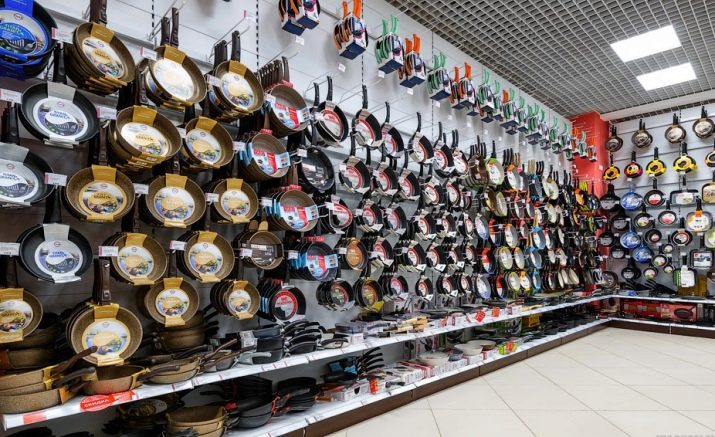
Requirements
Making pancakes is a delicate matter that requires some skill and a reliable frying pan. Therefore, the industry produces special kitchen utensils for frying pancakes. It has a thick bottom, small sides and a long handle. She needs to meet the following requirements:
- the dough in the pan must be evenly distributed;
- do not burn in any way;
- pancakes should be fried quickly, have a uniform structure;
- it is important that they easily turn over and take off without creating problems;
- in a frying pan, thin openwork and thick fluffy pancakes should be obtained equally well.
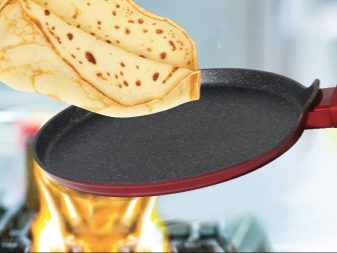

To meet the above requirements, a product must meet several parameters.
- The optimal height of the sides should be no more than 1 centimeter, then the pancakes can easily turn over. On sale you can find models with sides from 2 to 10 millimeters, if they are offered higher, then the pan is intended not only for pancakes.
- The thickness of the bottom of the pancake pan is 4–10 mm. If the parameters are too high, the pan will heat up for a long time and fry slowly. A small thickness of the bottom will lead to burning.
- In order for the pancake cooking process to take place safely, the handle must be long, comfortable in shape and not heat up during frying.The length of the handle is important if oil is used during cooking, and splashes can cause burns. For pans that do not require greasing, the size of the holder is not critical.
- The industry offers different shapes of pans. Round is considered a classic, pancakes in it turn out to be universal. They can be served with or without filling. The square shape can be used to make stuffed pancakes. If there are children in the house, they will love curly pancakes. For their manufacture, special pans are produced, but it will be more difficult to handle them - in order to turn such a pancake, you will need certain skills.
Important! The price of pancakes ranges from five hundred to several thousand rubles. You should not buy the cheapest one, because you will have to suffer with it for more than one year. Better to purchase later, but of good quality. The pancake pan can be used to cook omelets, pancakes and pancakes.

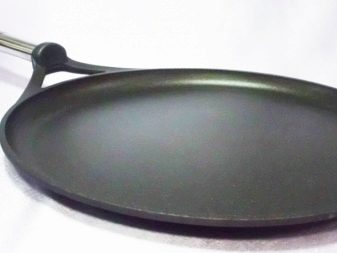
Review of materials
For the preparation of pancakes, high demands are placed on the material from which the frying pans are made. The amount of oil consumed during the frying process will depend on it. Some coatings do not require grease at all. In the past, pancakes were fried in universal cast iron pans. The process was uncomfortable, but the dish was excellent.
Today, less and less manufacturers use cast iron for their products. The emphasis is placed on light materials with a non-stick layer, marble chips or ceramic composition are used. The body material can be found from various types of metals and ceramics.
Copper products are more expensive, but have the longest service life. The budget models include aluminum and stainless steel.

Teflon coating
This material in use has its pros and cons. The advantages include the following indicators:
- despite the presence of a thick bottom, the pan is quite light; it is easy to work with, and the compacted bottom provides stable, even baking;
- the presence of a non-stick layer makes it possible to fry the product without oil;
- pancakes can be easily turned over and removed;
- the pan is washed with a regular sponge, but it should not be scratched with hard brushes or other abrasives.
The disadvantages include the following points:
- the pancake maker should not be heated to a temperature of +220 degrees; over time, on high heat, the surface deforms, cracks may appear, the protective layer is broken, the product will release toxic substances;
- to work with this type of frying pans, you will need special shovels made of wood or silicone;
- Teflon coating is afraid of mechanical stress - impacts, scratches, chips.
Important! When choosing a crepe maker, you should pay attention to the thickness of the non-stick layer - the larger it is, the more durable the product. But in any case, the service life of such models will not exceed 5-6 years.
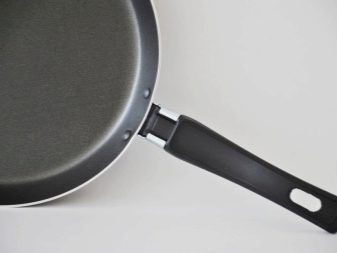

Ceramics
Ceramics in the manufacture of frying pans is used in two ways: a product is completely made from ekolon or thermolon, or the metal is coated with a nanocomposite material. The first products are lighter in weight than the second ones. The pluses include the following:
- an ecological component that does not harm health, while maintaining the taste of the product unchanged;
- you can fry pancakes without using grease;
- ceramic is more scratch resistant than teflon coating;
- does not create thermal deformation of the product;
- the pan heats up quickly and retains heat for a long time;
- the dough does not stick to the bottom, does not form carbon deposits;
- with careful use, the product has a long service life.
The disadvantages are as follows:
- ceramic products cannot be washed in a dishwasher, they are afraid of an alkaline environment;
- are heavy;
- are expensive.
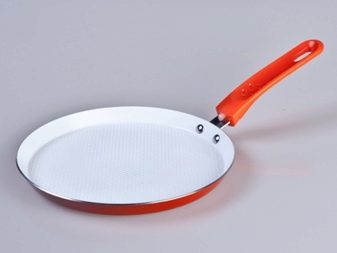
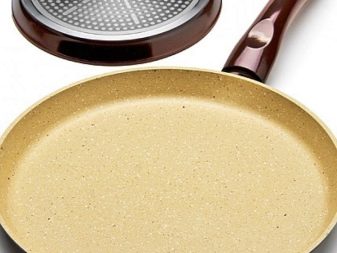
Marble coating
This coating is similar to ceramic. It is made from marble and granite chips. The product is based on cast aluminum. The advantages are manifested in the following:
- the marble layer withstands mechanical stress;
- pancake makers look beautiful, will decorate any kitchen;
- optimal bottom thickness contributes to uniform baking;
- pancakes do not burn, can be easily removed from the pan;
- the product is durable and versatile; you can fry other types of food on it.
The only disadvantages are the high cost of the goods.
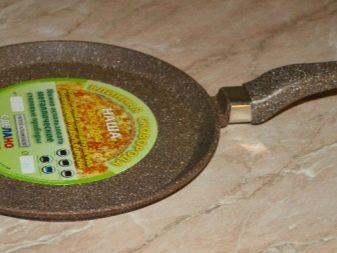
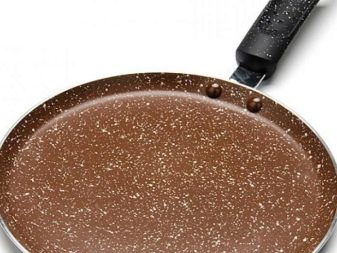
Stainless steel
This is a budget type of kitchen utensil. Steel has poor thermal conductivity and causes food to burn. To improve the situation, pans are made with a bottom consisting of five layers. But this does not always help. It is better to choose products with a combined bottom, in which steel layers alternate with aluminum ones. The advantages of such products include the following:
- the ability to leave dishes in a pan for storage, their taste does not change over time;
- dishwasher-safe;
- has a low cost.
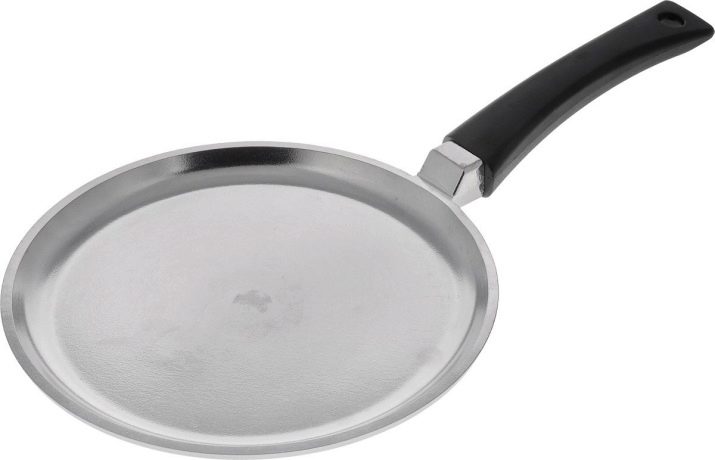
Aluminum
Aluminum is most often used for cabinet applications; products from it are stamped or cast. The first ones have a bottom thickness of 2.7 millimeters, they are less reliable and the product can burn, even if you use high quality pancake flour. Cast pans are available with thick sides and a bottom 5–7 mm thick. They are heavier than stamped ones, but more suitable for cooking. The advantages of aluminum include the following:
- fast heating;
- a light weight;
- Can be washed in the dishwasher;
- budget cost.
The following disadvantages should be noted:
- when frying, you must use oil;
- over time, the metal deforms from high temperatures, the effect of a "squeezed bottom" is created, which leads to uneven baking of pancakes;
- sometimes the appearance of oxide can be observed on the product.
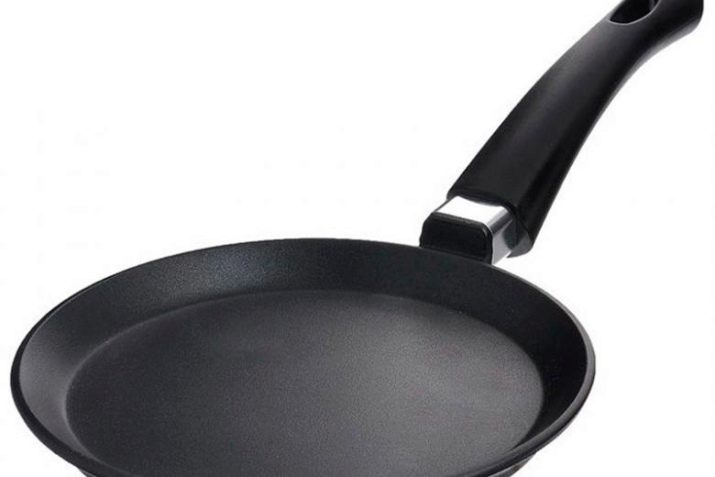
Cast iron
In cast-iron pans, any food is prepared in a special way, it languishes, concentrating its taste. In addition to pancakes, you can fry fish and meat products, stew vegetables on it. If you need a versatile product, you should choose a model with high sides, but its weight will be too heavy. A pan designed only for pancakes should be small, with low sides and a long holder. The advantages are as follows:
- heats up slowly, for a long time and keeps heat evenly;
- dishes on such a pancake maker are very tasty;
- environmentally friendly material;
- resistant to mechanical stress;
- durable, no expiration date.
It should be noted such disadvantages as:
- the product is heavy;
- cast iron has a porous structure and at first during the frying process there is a large consumption of oil, but gradually the pan acquires a natural non-stick layer, while reducing the consumption of fat;
- cast iron reacts to an acidic environment and can change the taste of food if tomatoes or lemon juice are used during cooking;
- the cooked dish should not be left in the pan, it is better to immediately put it into containers.
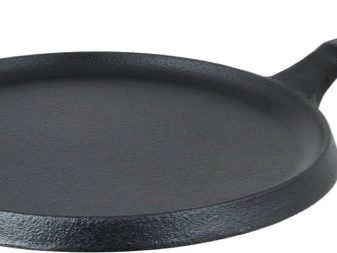
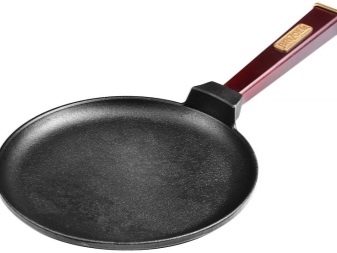
Copper
Copper pans can be a decoration for country, Provence, rustic or chalet kitchens. It is an expensive metal, but it has such advantages as:
- products made from it are beautiful and bright;
- durable, they can be inherited;
- environmentally friendly;
- warm up evenly and quickly, keeping warm for a long time;
- frying pancakes is perfect;
- The taste of food cooked in a copper pan is highly regarded by gourmets.
The disadvantages include the possibility of oxidation; the product will have to be periodically cleaned to return it to its original appearance. The cost of copper kitchen utensils is significantly higher than the prices of other metal models.
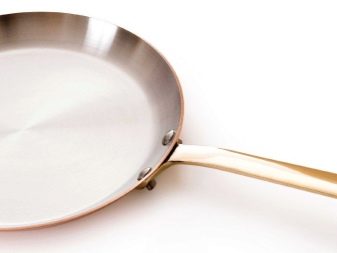
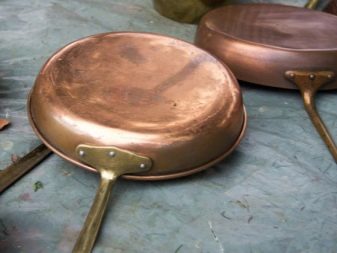
Titanium
In the manufacture of such pans, titanium oxide is added to the ceramic coating, and the product acquires super-strong non-stick properties. Cast aluminum is used for the housing base. The following advantages should be noted:
- the product is safe for health;
- has a low weight;
- resistant to mechanical stress;
- the material is durable, can serve for more than 20 years;
- heats up quickly, gives off heat for a long time;
- suitable for different types of plates;
- suitable for use in an oven;
- pancakes can be fried without adding oil.
There is only one drawback - high cost.
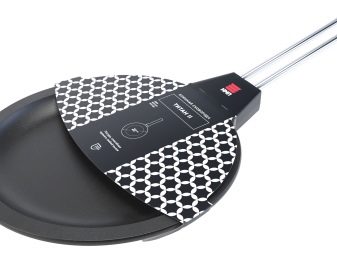
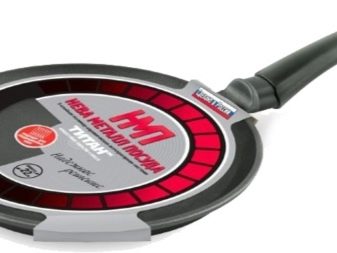
What should be the diameter?
The diameter of the pan can be measured along the bottom and top of the product. If the emphasis is on the size of the pancakes, the bottom parameters are important. If you need to fit the pancake maker on the shelf assigned to it, the capacity is measured along the top. When buying, consider the size of the burners. This does not apply to gas stoves, but applies to ceramic, induction. The standard sizes of the burners are 14.5, 18 and 22.5 cm. When choosing a frying pan, family preferences are taken into account: for small fluffy pancakes, the diameter of the product should not exceed 15 cm; for stuffed pancakes, the optimal size will be 25 or 26 cm.
Important! The larger the pan, the heavier it is, so a 20–22 cm product can be considered the most convenient option.
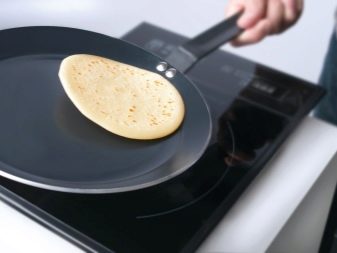
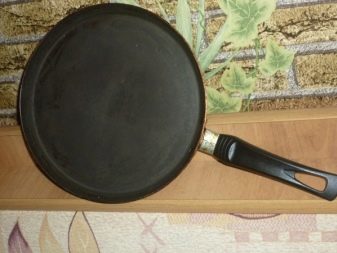
Model rating
The rating of pancake makers is based on feedback from consumers, those who bought and tested the pan in practice. We offer the top of the most popular models.
- "Biol" - this pancake pan is made in Ukraine. It has a diameter of 24 cm, a bottom thickness of 4 mm, and a removable wooden handle. The cast iron product guarantees uniform heating. The model has a budget cost. It is not provided with a non-stick coating and requires preliminary heating.
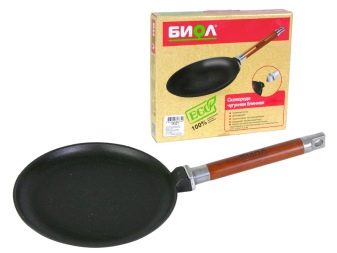
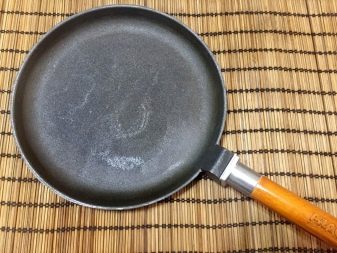
- Pancake pan Nadoba Is a modern type of kitchen utensil that does not require oil for cooking. It has a comfortable silicone handle.
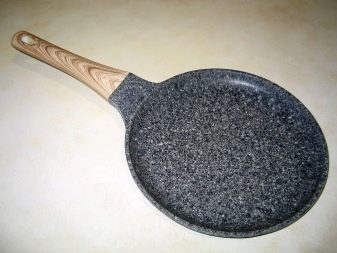
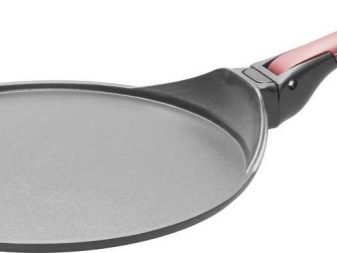
- Tefal - a frying pan made in France with a Teflon coating. Product diameter - 20 cm, endowed with an indicator that determines the degree of heating. No oil is required during cooking, the bottom heats up evenly, ensures uniform frying of pancakes.
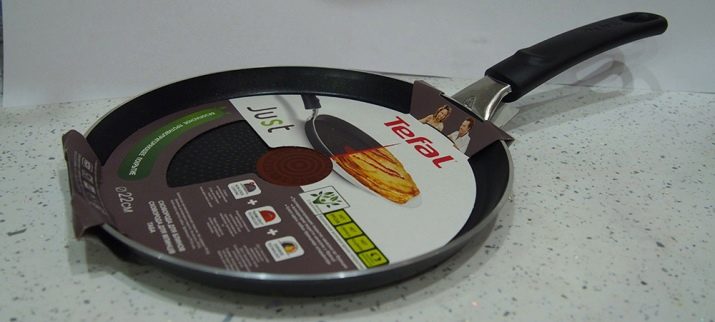
- Kukmara "Tradition" - a frying pan of Russian production (Tatarstan). It belongs to aluminum models protected by a ceramic coating. The bottom thickness is optimally balanced for perfect pancakes. The frying pan has high sides (6 millimeters), which makes it possible to use it for cooking various dishes. The amount of oil is used for frying a little, the diameter of the bottom is 26 cm. The model is equipped with a transparent lid and a pair of removable holders.


- Rondell mocco Is a product of German quality with a beautiful design. It has a heavy-duty non-stick titanium coating on an aluminum base. The pan has a diameter of 22 cm and the bottom is 4.5 mm thick. The conveniently shaped handle is endowed with anti-slip silicone parts. The only drawback may be the high cost of the product.
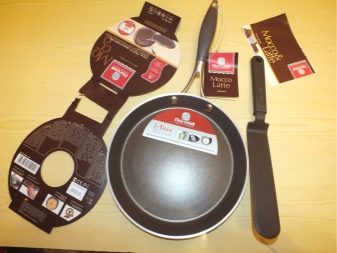

Reviews
Judging by the reviews, pancake pans are in great demand, people share their impressions and tips. After analyzing them, we can conclude that for many, cast-iron models on which our grandmothers fried pancakes are still the best product. They are heavy but they bake great. There have been several negative reviews about the corrosion that sometimes occurs on such pancake makers.
Frying pans were highly appreciated Tefal, as well as expensive ceramic and marble products. They satisfy literally everyone, with the exception of a few demanding users. For example, we were looking for a frying pan in which the minimum amount of dough can instantly spread in a thin layer over the pan and also fry quickly. We bought Tefal, but the product did not cope with the task.
Many are satisfied with the cheapest models, they just change them every three years.
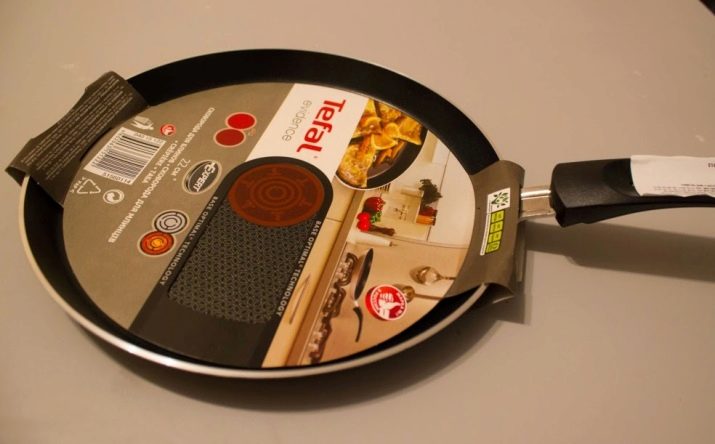
Judging by the reviews, the perfect skillet doesn't have to be expensive. If you take care of it properly, any product will last a long time.
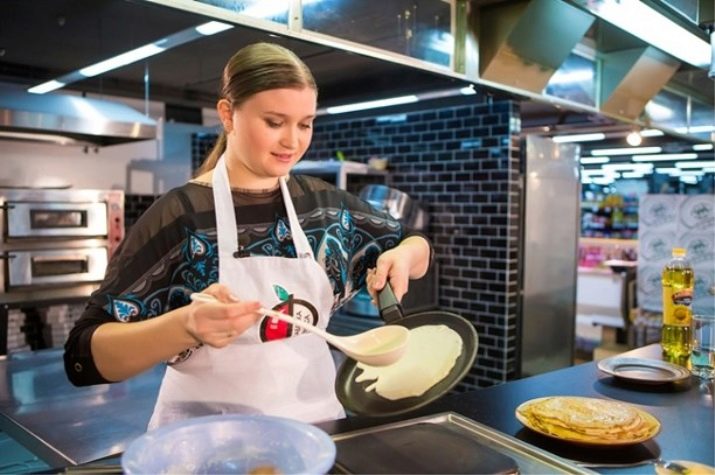
For information on which pancake pan is better to buy, see below.








